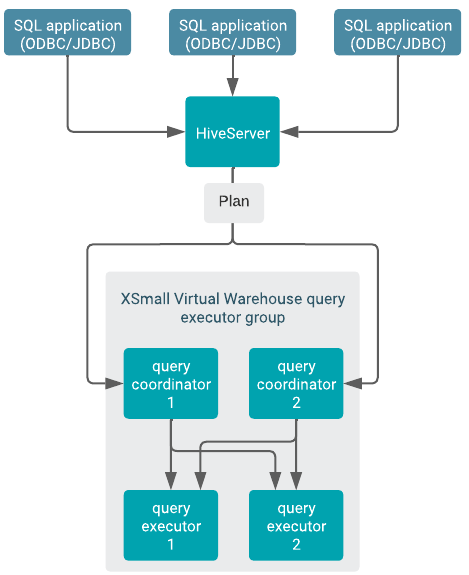Concurrency autoscaling
Concurrency autoscaling is an option you can set while creating a Hive Virtual Warehouse. Understand how concurrency autoscaling works and when to use it.
What is concurrency autoscaling
- HiveServer
- Receives all incoming queries and generates a preliminary query plan that does not include distributing the query across executor nodes. Then it looks for an available query coordinator to send the plan to executor nodes for distribution.
- Query coordinators
- Receives the serialized plan from HiveServer and generates the final query plan that distributes the query tasks across executor nodes for execution. There are as many query coordinators as executor nodes, but there is no one-to-one mapping. Instead, each query coordinator interacts only with the executor nodes in a group. For example, if you create a Virtual Warehouse that has 10 nodes (SMALL-size) and you scale up to 30 nodes by 10-node increments, a single query coordinator can only utilize the 10 executors from one group. They can never interact with executors from other groups. This supports effective isolation. Also it is important to note that one query coordinator can only orchestrate the execution of tasks for one query at a time, so the number of query coordinators determines your query parallelism limit.
- Query executor containers
- Can run multiple tasks of one or multiple different queries. Query executor nodes determine the throughput of your system. They are the executors which are the unit of sizing for Virtual Warehouses.
- Executor groups
- A group of executors that can run queries. The size of executor group is determined by the size you choose when you first create the Virtual Warehouse (XSMALL, SMALL, MEDIUM, or LARGE). The Virtual Warehouse size determines the maximum number of queries that each executor group can run concurrently. For example, if you create a SMALL Virtual Warehouse, each executor group can handle 10 parallel queries or tasks of up to 10 queries. A single query is always contained within a single executor group and never spans multiple executor groups. The throughput for an individual query is determined by the original size of the warehouse.
How concurrency autoscaling works
When the query load increases, auto-scaling increases. The query load grows proportionally with the number of concurrent queries and query complexity.

A single query on an idle Virtual Warehouse does not cause automatic scaling of resources. The query uses the resources available at the time of the query submission. Only subsequent queries can cause auto scaling. Additional query executor groups are added for scaling the resources.
The number of simultaneously running queries are equal to the number of query coordinators. A query executor can run 12 query fragments at the same time. The size of executor groups is determined by the size you choose when you create the Virtual Warehouse (XSMALL, SMALL, MEDIUM, or LARGE). A single query is always contained within a single executor group and never spans multiple executor groups. The throughput for an individual query is determined by the original size of the warehouse.

- When users connect to Hive Virtual Warehouses using SQL applications such as Hue or other SQL clients that use JDBC or ODBC, the query is handled by HiveServer. First HiveServer generates a logical plan that does not include distributing the query tasks across executor nodes.
- Then HiveServer locates an available query coordinator in the Virtual Warehouse to handle the query. The query coordinator generates the physical query plan that distributes the query tasks across executor nodes for execution and locates available query executors to handle each query task. Each query coordinator can send query tasks to all query executors in the executor group and try to optimize for cache locality.
- Auto-scaling occurs when either the headroom, or wait time, exceeds the threshold you configure. Additional query executor groups are added to perform the scaling.
There are as many query coordinators as executors, but there is no one-to-one mapping. Instead, each query coordinator can interact with all executors. However, one query coordinator can only orchestrate the execution of tasks for one query at a time, so the number of query coordinators determines the query parallelism limit.
Executors: The number of executors you need for a workload is analogous to the number of nodes needed for an on-premises workload.
Headroom: The number of available coordinators that trigger auto-scaling. For example, if Desired Free Capacity is set to 1 on an XSMALL-sized Virtual Warehouse, which has 2 executors, when there is less than one free coordinator (2 queries are concurrently executing), the warehouse auto-scales up and an additional executor group is added.
Wait Time: How long do queries wait in the queue to execute? A query is queued if it arrives on HiveServer and no coordinator is available. For example, if Wait Time is set to 10, queries wait to execute in the queue for 10 seconds. The warehouse auto scales up and adds an additional executor group. This ensures that your Virtual Warehouse does not take resources away from other workloads.
What concurrency autoscaling is best suited for
- Number of concurrent queries
- Complexity of queries
- Amount of data scanned by the queries
- Number of queries
